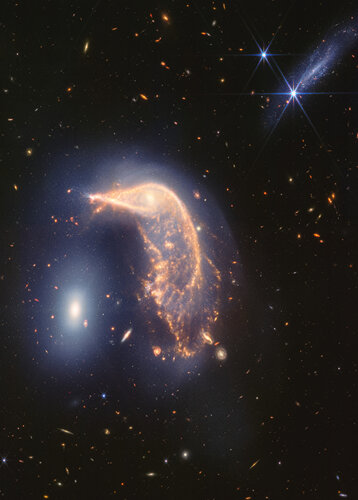Let’s dance
Before their first approach, the Penguin held the shape of a spiral. Today, its galactic centre gleams like an eye, its unwound arms now shaping a beak, head, backbone, and fanned-out tail.
Like all spiral galaxies, the Penguin is still very rich in gas and dust. The galaxies’ ‘dance’ pulled gravitationally on the Penguin’s thinner areas of gas and dust, causing them to crash in waves and form stars. Look for those areas in two places: what looks like a fish in its ‘beak’ and the ‘feathers’ in its ‘tail’.
Surrounding these newer stars is smoke-like material that includes carbon-containing molecules, known as polycyclic aromatic hydrocarbons, which Webb is exceptional at detecting. Dust, seen as fainter, deeper orange arcs also swoops from its beak to tail feathers.
In contrast, the Egg’s compact shape remains largely unchanged. As an elliptical galaxy, it is filled with ageing stars, and has a lot less gas and dust that can be pulled away to form new stars. If both were spiral galaxies, each would end the first ‘twist’ with new star formation and twirling curls, known as tidal tails.
Another reason for the Egg’s undisturbed appearance is that these galaxies have approximately the same mass, which is why the smaller-looking elliptical wasn’t consumed or distorted by the Penguin.
It is estimated that the Penguin and the Egg are about 100 000 light-years apart – quite close in astronomical terms. For context, the Milky Way galaxy and our nearest neighbour, the Andromeda Galaxy, are about 2.5 million light-years apart, about 30 times the distance. They too will interact, but not for about 4 billion years.
In the top right of the image is an edge-on galaxy, catalogued PGC 1237172, which resides 100 million light-years closer to Earth. It’s also quite young, teeming with new, blue stars. In Webb’s mid-infrared-only image, PGC 1237172 practically disappears. Mid-infrared light largely captures cooler, older stars and an incredible amount of dust. Since the galaxy’s stellar population is so young, it ‘vanishes’ in mid-infrared light.
Webb’s image is also overflowing with distant galaxies. Some have spiral and oval shapes, like those threaded throughout the Penguin’s ‘tail feathers’, while others scattered throughout are shapeless dots. This is a testament to the sensitivity and resolution of the telescope’s infrared instruments. (Compare Webb’s view to the 2013 image from the NASA/ESA Hubble Space Telescope.) Even though these observations only took a few hours, Webb revealed far more distant, redder, and dustier galaxies than previous telescopes – one more reason to expect Webb to continue to expand our understanding of everything in the Universe.
Arp 142 lies 326 million light-years from Earth in the constellation Hydra.



